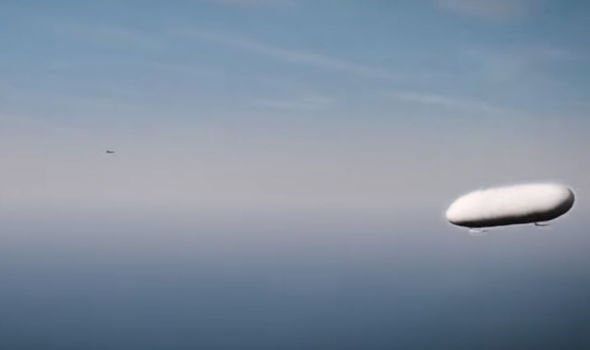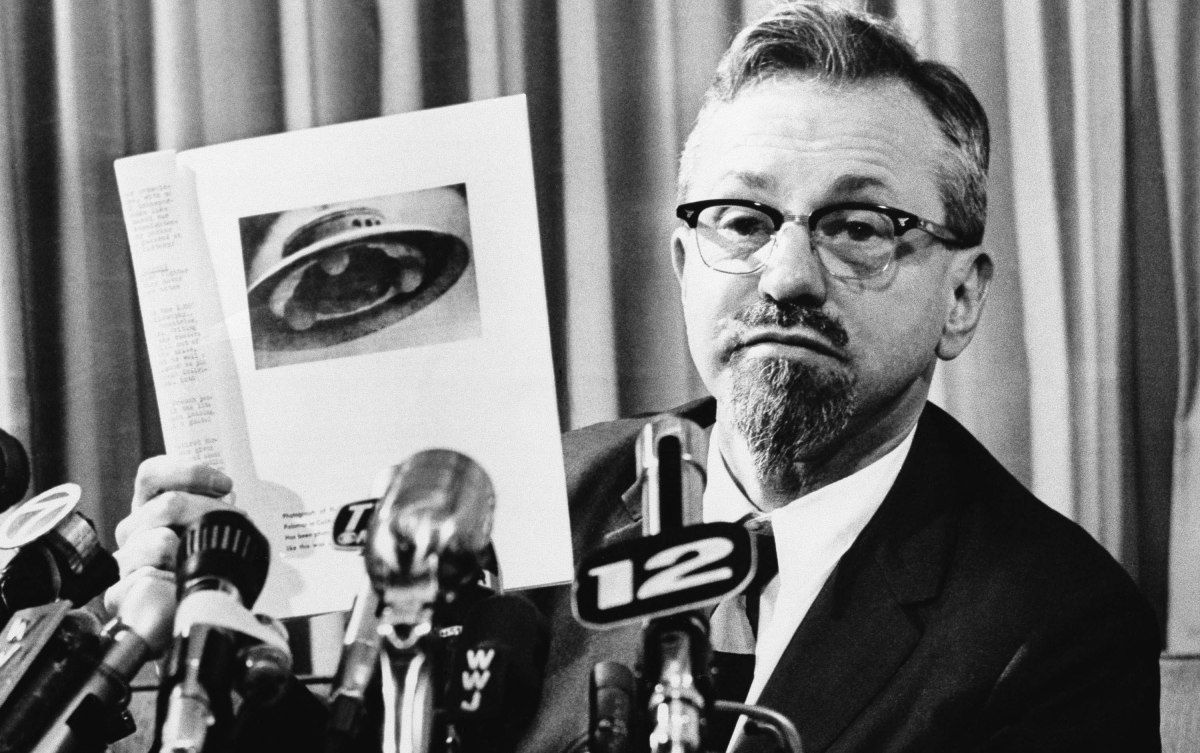by Greg Daugherty November 19, 2018 (history.com)
• In 1947, a rash of reports of UFOs had the public on edge. The Air Force created Project Sign to investigate these UFO sightings. But they needed outside expertise to sift through the reports and come up with explanations for all of these sightings. Enter J. Allen Hynek.
• In 1948, Hynek was the 37-year-old director at Ohio State University’s McMillin Observatory. He had worked for the government during WWII developing new defense technologies for the war effort with a high security clearance. The Air Force approached him to be a consultant on ‘flying saucers’ for the government. “I had scarcely heard of UFOs in 1948 and, like every other scientist I knew, assumed that they were nonsense,” Hynek recalled.
• Hynek’s UFO investigations under Project Sign resulted in twenty percent of the 237 cases that couldn’t be explained. In February 1949, Project Sign was succeeded by Project Grudge, which said Hynek, “took as its premise that UFOs simply could not be.” The 1949 Grudge report concluded that the phenomena posed no danger to the United States, and warranted no further study.
• But UFO incidents continued, even from the Air Force’s own radar operators. The national media began treating the phenomenon more seriously. The Air Force had little choice but to revive Project Grudge under a new name: Project Blue Book. Hynek joined Project Blue Book in 1952 and would remain with it until its demise in 1969. But he had changed his mind about the existence of UFOs. “The witnesses I interviewed could have been lying, could have been insane or could have been hallucinating collectively—but I do not think so,” he recalled in 1977. Hynek deplored the ridicule that people who reported a UFO sighting often had to endure, causing untold numbers of others to never come forward, not to mention the loss of useful research data.
• “Given the controversial nature of the subject, it’s understandable that both scientists and witnesses are reluctant to come forward,” said Jacques Vallee, co-author with Dr. Hynek of The Edge of Reality: A Progress Report on Unidentified Flying Objects.
• On October 4, 1957, the Soviet Union surprised the world by launching Sputnik, a serious blow to Americans’ sense of technological superiority. Hynek was on TV assuring Americans that their scientists were closely monitoring the situation. UFO sightings continued unabated.
• In the 1960s, Hynek was the top expert on UFOs as scientific consultant to Project Blue Book. But he chafed at what he perceived as the project’s mandate to debunk UFO sightings, and the inadequate resources at his disposal. Air Force Major Hector Quintanilla, who headed the project from 1963 to 1969, writes that he considered Hynek a “liability.”
• Hynek frustrated UFO debunkers such as the U.S. Air Force. But in 1966, after suggesting that a UFO sighting in Michigan may have been an optical illusion created by swamp gas, he became a punchline for UFO believers as well.
• In his testimony for a Congressional hearing in 1966, Hynek stated, “[I]t is my opinion that the body of data accumulated since 1948…deserves close scrutiny by a civilian panel of physical and social scientists…”. The Air Force established a civilian committee of scientists to investigate UFOs, chaired by physicist, Dr. Edward U. Condon. In 1968, Hynek assailed the Condon Report’s conclusion that “further extensive study of UFOs probably cannot be justified.” In 1969, Project Blue Book shut down for good.
• UFO sightings continued around the world. Hynek later quipped, “apparently [they] did not read the Condon Report”. Hynek went on with his research, free from the compromises and bullying of the U.S. Air Force.
• In 1972, Hynek published his first book, The UFO Experience. It introduced Hynek’s classifications of UFO incidents, which he called Close Encounters. Close Encounters of the First Kind meant UFOs seen at a close enough range to make out some details. In a Close Encounter of the Second Kind, the UFO had a physical effect, such as scorching trees, frightening animals or causing car motors to suddenly conk out. In Close Encounters of the Third Kind, witnesses reported seeing occupants in or near a UFO.
• In 1977, Steven Spielberg released the movie, Close Encounters of the Third Kind. Hynek was paid $1,000 for the use of the title, another $1,000 for the rights to use stories from the book and $1,500 for three days of technical consulting. He also had a brief cameo in the film, playing an awestruck scientist when the alien spacecraft comes into view.
• In 1978, Hynek retired from teaching. In 1973 he had founded the Center for UFO Studies which continues to this day. Hynek died in 1986, at age 75, from a brain tumor.
It’s September 1947, and the U.S. Air Force has a problem. A rash of reports about mysterious objects in the skies has the public on edge and the military baffled. The Air Force needs to figure out what’s going on—and fast. It launches an investigation it calls Project Sign.
By early 1948 the team realizes it needs some outside expertise to sift through the reports it’s receiving—specifically an astronomer who can determine which cases are easily explained by astronomical phenomena, such as planets, stars or meteors.
For J. Allen Hynek, then the 37-year-old director at Ohio State University’s McMillin Observatory, it would be a classic case of being in the right place at the right time—or, as he may have occasionally lamented, the wrong place at the wrong one.
The adventure begins
Hynek had worked for the government during the war, developing new defense technologies like the first radio-controlled fuse, so he already had a high security clearance and was a natural go-to.
“One day I had a visit from several men from the technical center at Wright-Patterson Air Force base, which was only 60 miles away in Dayton,” Hynek later wrote. “With some obvious embarrassment, the men eventually brought up the subject of ‘flying saucers’ and asked me if I would care to serve as consultant to the Air Force on the matter… The job didn’t seem as though it would take too much time, so I agreed.”
Little did Hynek realize that he was about to begin a lifelong odyssey that would make him one of the most famous and, at times, controversial scientists of the 20 century. Nor could he have guessed how much his own thinking about UFOs would change over that period as he persisted in bringing rigorous scientific inquiry to the subject.
“I had scarcely heard of UFOs in 1948 and, like every other scientist I knew, assumed that they were nonsense,” he recalled.
Project Sign ran for a year, during which the team reviewed 237 cases. In Hynek’s final report, he noted that about 32 percent of incidents could be attributed to astronomical phenomena, while another 35 percent had other explanations, such as balloons, rockets, flares or birds. Of the remaining 33 percent, 13 percent didn’t offer enough evidence to yield an explanation. That left 20 percent that provided investigators with some evidence but still couldn’t be explained.
The Air Force was loath to use the term “unidentified flying object,” so the mysterious 20 percent were simply classified as “unidentified.”
In February 1949, Project Sign was succeeded by Project Grudge. While Sign offered at least a pretense of scientific objectivity, Grudge seems to have been dismissive from the start, just as its angry-sounding name suggests. Hynek, who played no role in Project Grudge, said it “took as its premise that UFOs simply could not be.” Perhaps not surprisingly, its report, issued at the end of 1949, concluded that the phenomena posed no danger to the United States, having resulted from mass hysteria, deliberate hoaxes, mental illness or conventional objects that the witnesses had misinterpreted as otherworldly. It also suggested the subject wasn’t worth further study.
Project Blue Book is born
That might’ve been the end of it. But UFO incidents continued, including some puzzling reports from the Air Force’s own radar operators. The national media began treating the phenomenon more seriously; LIFE magazine did a 1952 cover story, and even the widely respected TV journalist Edward R. Murrow devoted a program to the topic, including an interview with Kenneth Arnold, a pilot whose 1947 sighting of mysterious objects over Mount Rainier in Washington state popularized the term “flying saucer.” The Air Force had little choice but to revive Project Grudge, which soon morphed into the more benignly named Project Blue Book.
Hynek joined Project Blue Book in 1952 and would remain with it until its demise in 1969. For him, it was a side gig as he continued to teach and to pursue other, non-UFO research, at Ohio State. In 1960 he moved to Northwestern University in Evanston, Illinois, to chair its astronomy department.
As before, Hynek’s role was to review the reports of UFO sightings and determine whether there was a logical astronomical explanation. Typically that involved a lot of unglamorous paperwork; but now and then, for an especially puzzling case, he had a chance to get out into the field.
There he discovered something he might never have learned from simply reading the files: how normal the people who reported seeing UFOs tended to be. “The witnesses I interviewed could have been lying, could have been insane or could have been hallucinating collectively—but I do not think so,” he recalled in his 1977 book, The Hynek UFO Report.
“Their standing in the community, their lack of motive for perpetration of a hoax, their own puzzlement at the turn of events they believe they witnessed, and often their great reluctance to speak of the experience—all lend a subjective reality to their UFO experience.”
READ ENTIRE ARTICLE
FAIR USE NOTICE: This page contains copyrighted material the use of which has not been specifically authorized by the copyright owner. ExoNews.org distributes this material for the purpose of news reporting, educational research, comment and criticism, constituting Fair Use under 17 U.S.C § 107. Please contact the Editor at ExoNews with any copyright issue.
 This month, mysterious lights startled some people looking to the skies in Milwaukee, Wisconsin. Readers of this
This month, mysterious lights startled some people looking to the skies in Milwaukee, Wisconsin. Readers of this


 “We got a call that the Mannors out in Dexter seen a UFO,” says Doug Harvey who was the Washtenaw County Sheriff at the time. “So I went out there and the grass was down flat in a round circle…and they said they definitely seen an object come down and lift off.”
“We got a call that the Mannors out in Dexter seen a UFO,” says Doug Harvey who was the Washtenaw County Sheriff at the time. “So I went out there and the grass was down flat in a round circle…and they said they definitely seen an object come down and lift off.”
